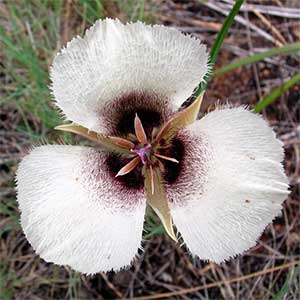Calochortus umpquaensis
Calochortus clavatus
Umpqua mariposa-lily
club hair mariposa, clubhair mariposa lily, slender mariposa lily
not branching, straight, often scapelike, 2–3 dm, glabrous or glaucous.
slender or coarse, stout, branching or not, strongly flexuous, 3–10 dm.
basal solitary, clasping;
blade narrowly lanceolate, hairy, adaxially hispid, abaxially glabrous, sometimes glaucous. Inflorescences 1–several-flowered;
bracts 2, suboppo-site, narrowly lanceolate.
basal withering, 1–2 dm;
blade linear.
subumbellate, 1–6-flowered;
bracts 4–8 cm, bases dilated.
erect;
perianth open, campanulate;
sepals lanceolate-acuminate, ca. 2 cm;
petals white to cream, with dark purple-black, pentagonal to lunate blotch, broadly oblong to obovate, 3.5 cm, bearded, adaxial surface typically minutely papillose, margins erose;
glands transversely oblong-lunate, slightly depressed, with 0.7–1.4 mm-wide band of short dendritic hairs distally, hairs surrounded by lime-green coloration and purple striations;
anthers lanceolate, apex acuminate.
erect;
perianth open, cup-shaped;
sepals usually with red-brown blotch at base, lanceolate-ovate, 2–4 cm, apex acute;
petals lemon to golden yellow, with transverse line distal to gland, broadly cuneate to obovate, 3–5 cm;
glands round, deeply depressed, densely covered with short hairs with branching, coralline tips, surrounded by conspicuously fringed membrane and club-shaped hairs;
filaments ca. 10 mm;
anthers purplish brown, oblong, 4–10 mm.
nodding, 3–5.4 cm.
erect, lanceoloid-linear, angled, 6–9 cm, apex acuminate.
2.8–3.5 mm, with inflated bulbous crest and hollow lateral ridge.
light yellow, translucent, flat.
= 20.
= 16.
Calochortus umpquaensis
Calochortus clavatus
Of conservation concern.
Calochortus umpquaensis is known only from Watson and Ace Williams mountains on both sides of the Little River, Douglas County.
(Discussion copyrighted by Flora of North America; reprinted with permission.)
Varieties 5 (5 in the flora).
(Discussion copyrighted by Flora of North America; reprinted with permission.)
1. Petals shorter than sepals; petal glands very deeply depressed. | var. avius |
1. Petals longer than sepals; petal glands shallowly to moderately depressed. | → 2 |
2. Stems straight, slender, usually 3 dm or shorter. | → 2 |
2. Stems flexuous, coarse, usually 5–10 dm. | → 3 |
3. Petals 3–4 cm, sparsely bearded; leaves not recurved. | var. gracilis |
3. Petals 4–5 cm, bearded; leaves strongly recurved. | var. recurvifolius |
4. Petals deep yellow, hairs very knobby; anthers deep purple. | var. clavatus |
4. Petals light yellow, hairs not very knobby; anthers yellow to medium purple. | var. pallidus |


